英语名词单数变复数规则
英语名词单数变复数的规则

英语名词单数变复数的规则:优质解答一、绝大多数的可数名词的复数形式,是在该词末尾加上后辍-s.读音变化:结尾是清辅音读[s],结尾是浊辅音或元音读[z].例:friend→friends; cat→cats; style→styles; sport→sports; piece→pieces二、凡是以s、z、x、ch、sh结尾的词,在该词末尾加上后辍-es构成复数.读音变化:统一加读[iz].例:bus→buses; quiz→quizzes; fox→foxes; match→matches; flash→flashes三、以辅音字母+y结尾的名词,将y改变为i,再加-es.读音变化:加读[z].例:candy→candies; daisy→daisies; fairy→fairies; lady →ladies; story→stories四、以-o结尾的名词,如果不是外来词或缩写,就加-es,否则加-s构成复数.读音变化:加读[z].例:tomato→tomatoes; potato→potatoes; torpedo→torpedoes; bingo→bingoes反例:silo→silos; piano→pianos(外来词); photo→photos; macro→macros(缩写词)五、以-f或-fe结尾的名词,多为将-f或-fe改变为-ves,但有例外.读音变化:尾音[f]改读[vz].例:knife→knives; life→lives; leaf→leaves; staff→staves; scarf→scarves反例:roof→roofs六、以-us结尾的名词(多为外来词),通常将-us改变为-i 构成复数.读音变化:尾音[Es]改读[ai],其中[kEs]要改读为[sai],[gEs]要改读为[dVai].例:fungus→fungi; abacus→abaci; focus→foci; cactus →cacti; cestus→cesti七、以-is结尾的名词,通常将-is改变为-es.读音变化:尾音[is]改读[i:z].例:axis→axes; basis→bases; naris→nares; hypothesis →hypotheses; restis→restes八、以-ix结尾的名词,通常将-ix改变为-ices,但有例外.读音变化:尾音[iks]改读[isi:z].例:matrix→matrices; directrix→directrices; calix→calices; appendix→appendices 反例:affix→affixes 九、以-um结尾的名词,将-um改变为-a.读音变化:去掉鼻尾音[m].例:forum→fora; stadium→stadia; aquarium→aquaria; datum→data; vacuum→vacua十、以-a结尾的名词,在该词末尾加上后辍-e.读音变化:尾音[E]改读[i:].例:larva→larvae; formula→formulae; ala→alae; media →mediae; hydra→hydrae十一、部分单词的复数形式不变.读音变化:保持原音.例:fish→fish; sheep→sheep; cattle→cattle; deer→deer; salmon→salmon十二、极少数单词,其复数形式没有任何规律.读音变化:没有规律.例:man→men; woman→women; child→children; person→people; ox→oxen十三、一些单数词得加en才能变成复数词:例:ox→oxen; child→children; brother→brethren十四、一些单数词得改头换面一番,才能变成复数词例:analysis→analyses分析; basis→bases基础; datum →data数据; foot→feet;formula→formulae/formulas公式; goose→geese; louse→lice虱子; man→menmouse→mice; medium→media/mediums媒介; memorandum→memoranda/memorandums备忘录; parenthesis→parentheses 圆括号; phenomenon→phenomena现象; radius→radii 半径tooth→teeth; woman→women十五、有些名词是单数、复数不分的例:deer; fish; cannon; sheep; salmon 鲑鱼; trout 鳟鱼十六、一些名词虽分单数、复数,但出现次数多的总是单数词例:abscence; clothing; film; help; furniture家具; machinery机械; news; scenery风景; sugar;traffic交通十七、另一些名词则以复数词出现的机会较多例:bellows风箱; clothes; police; shorts短裤; scissors 剪刀; spectacles眼镜; shears大剪刀trousers长裤; wages工资十八、compound nouns,这类复数词是以主要的名词来表示例:daughter-in-law→daughters-in-law 媳妇; father-in-law→fathers-in-law岳父man-of-war→men-of-war兵舰; maid-servant→maid-servantsstep-son→step-sons晚子; son-in-law→sons-in-law十九、若表达具体数目,要借助数量词例:pair(对,双); suit(套); a pair of glasses; two pairs of trousers二十、另外还有一些名词,其复数形式有时可表示特别意思, 例:goods货物,waters水域,fishes(各种)鱼二十一、除人民币元、角、分外,美元、英镑、法郎等都有复数形式.例:a dollar,two dollars; a meter,two meters。
英语名词单数变复数的规则
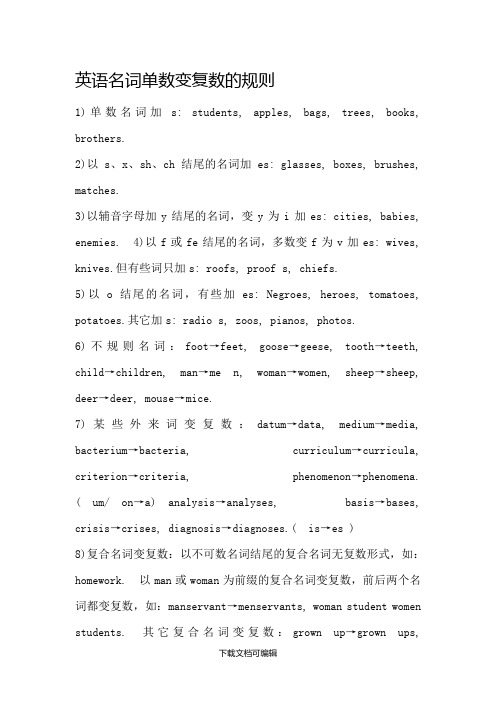
英语名词单数变复数的规则1)单数名词加s: students, apples, bags, trees, books, brothers.2)以s、x、sh、ch结尾的名词加es: glasses, boxes, brushes, matches.3)以辅音字母加y结尾的名词,变y为i加es: cities, babies, enemies.4)以f或fe结尾的名词,多数变f为v加es: wives, knives.但有些词只加s: roofs, proof s, chiefs.5)以o结尾的名词,有些加es: Negroes, heroes, tomatoes, potatoes.其它加s: radio s, zoos, pianos, photos.6)不规则名词:foot→feet, goose→geese, tooth→teeth, child→children, man→me n, woman→women, sheep→sheep, deer→deer, mouse→mice.7)某些外来词变复数:datum→data, medium→media, bacterium→bacteria, curriculum→curricula, criterion→criteria, phenomenon→phenomena. (um/on→a)analysis→analyses, basis→bases, crisis→crises, diagnosis→diagnoses.(is→es )8)复合名词变复数:以不可数名词结尾的复合名词无复数形式,如:homework.以man或woman为前缀的复合名词变复数,前后两个名词都变复数,如:manservant→mens ervants, woman student women students.其它复合名词变复数:grown up→grown ups,brother in law→brothers in law,stand by→stands by.9)复合形容词做定语时,其中的名词保持单数:a six year old boy,a two hundred page book名词复数:)~~英语中名词可分为可数名词和不可数名词。
英语名词单数变复数主要规则

英语名词单数变复数主要有以下规则一、绝大多数的可数名词的复数形式,是在该词末尾加上后辍-s。
读音变化:结尾是清辅音读[s],结尾是浊辅音或元音读[z]。
例:friend→friends; cat→cats; style→styles; sport→sports; piece→pieces二、凡是以s、z、x、ch、sh结尾的词,在该词末尾加上后辍-es构成复数。
读音变化:统一加读[iz]。
例:bus→buses; quiz→quizzes; fox→foxes; match→matches; flash→flashes box →boxes; watch →watches; actress →actresses; class →classes; coach(长途车)→coaches; dress →dresses; sandwich →sandwiches; toothbrush →toothbrushes; waitress(女侍者)→waitresses三、以辅音字母+y结尾的名词,将y改变为i,再加-es。
读音变化:加读[z]。
例:candy→candies; daisy(雏菊)→daisies; fairy→fairies; lady→ladies; story→storiesstrawberry →strawberries; baby →babies; puppy →puppies; library →libraries; dictionary →dictionaries; cherry →cherries; activity →activities四、以-o结尾的名词,如果不是外来词或缩写,就加-es,否则加-s构成复数。
(有生命的加es,无生命的加s)读音变化:加读[z]。
例:tomato→tomatoes; potato→potatoes; torpedo(鱼雷)→torpedoes; bingo(彩票式游戏)→bingoes反例:silo(青贮塔)→silos; piano→pianos(外来词); photo→photos; macro(宏指令,计机算语言)→macros(缩写词)五、以-f或-fe结尾的名词,多为将-f或-fe改变为-ves,但有例外。
英语名词单数变复数的规则
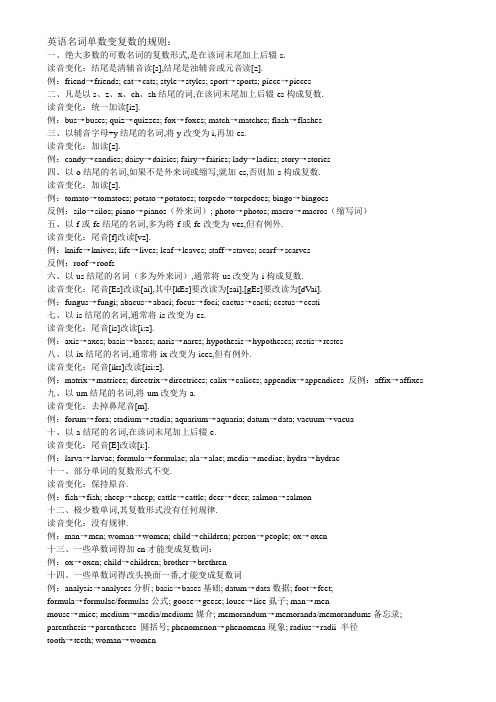
英语名词单数变复数的规则:一、绝大多数的可数名词的复数形式,是在该词末尾加上后辍-s.读音变化:结尾是清辅音读[s],结尾是浊辅音或元音读[z].例:friend→friends; cat→cats; style→styles; sport→sports; piece→pieces二、凡是以s、z、x、ch、sh结尾的词,在该词末尾加上后辍-es构成复数.读音变化:统一加读[iz].例:bus→buses; quiz→quizzes; fox→foxes; match→matches; flash→flashes三、以辅音字母+y结尾的名词,将y改变为i,再加-es.读音变化:加读[z].例:candy→candies; daisy→daisies; fairy→fairies; lady→ladies; story→stories四、以-o结尾的名词,如果不是外来词或缩写,就加-es,否则加-s构成复数.读音变化:加读[z].例:tomato→tomatoes; potato→potatoes; torpedo→torpedoes; bingo→bingoes反例:silo→silos; piano→pianos(外来词); photo→photos; macro→macros(缩写词)五、以-f或-fe结尾的名词,多为将-f或-fe改变为-ves,但有例外.读音变化:尾音[f]改读[vz].例:knife→knives; life→lives; leaf→leaves; staff→staves; scarf→scarves反例:roof→roofs六、以-us结尾的名词(多为外来词),通常将-us改变为-i构成复数.读音变化:尾音[Es]改读[ai],其中[kEs]要改读为[sai],[gEs]要改读为[dVai].例:fungus→fungi; abacus→abaci; focus→foci; cactus→cacti; cestus→cesti七、以-is结尾的名词,通常将-is改变为-es.读音变化:尾音[is]改读[i:z].例:axis→axes; basis→bases; naris→nares; hypothesis→hypotheses; restis→restes八、以-ix结尾的名词,通常将-ix改变为-ices,但有例外.读音变化:尾音[iks]改读[isi:z].例:matrix→matrices; directrix→directrices; calix→calices; appendix→appendices 反例:affix→affixes 九、以-um结尾的名词,将-um改变为-a.读音变化:去掉鼻尾音[m].例:forum→fora; stadium→stadia; aquarium→aquaria; datum→data; vacuum→vacua十、以-a结尾的名词,在该词末尾加上后辍-e.读音变化:尾音[E]改读[i:].例:larva→larvae; formula→formulae; ala→alae; media→mediae; hydra→hydrae十一、部分单词的复数形式不变.读音变化:保持原音.例:fish→fish; sheep→sheep; cattle→cattle; deer→deer; salmon→salmon十二、极少数单词,其复数形式没有任何规律.读音变化:没有规律.例:man→men; woman→women; child→children; person→people; ox→oxen十三、一些单数词得加en才能变成复数词:例:ox→oxen; child→children; brother→brethren十四、一些单数词得改头换面一番,才能变成复数词例:analysis→analyses分析; basis→bases基础; datum→data数据; foot→feet;formula→formulae/formulas公式; goose→geese; louse→lice虱子; man→menmouse→mice; medium→media/mediums媒介; memorandum→memoranda/memorandums备忘录; parenthesis→parentheses 圆括号; phenomenon→phenomena现象; radius→radii 半径tooth→teeth; woman→women十五、有些名词是单数、复数不分的例:deer; fish; cannon; sheep; salmon 鲑鱼; trout 鳟鱼十六、一些名词虽分单数、复数,但出现次数多的总是单数词例:abscence; clothing; film; help; furniture家具; machinery机械; news; scenery风景; sugar; traffic交通十七、另一些名词则以复数词出现的机会较多例:bellows风箱; clothes; police; shorts短裤; scissors剪刀; spectacles眼镜; shears大剪刀trousers长裤; wages工资十八、compound nouns,这类复数词是以主要的名词来表示例:daughter-in-law→daughters-in-law 媳妇; father-in-law→fathers-in-law岳父man-of-war→men-of-war兵舰; maid-servant→maid-servantsstep-son→step-sons晚子; son-in-law→sons-in-law十九、若表达具体数目,要借助数量词例:pair(对,双); suit(套); a pair of glasses; two pairs of trousers二十、另外还有一些名词,其复数形式有时可表示特别意思,例:goods货物,waters水域,fishes(各种)鱼二十一、除人民币元、角、分外,美元、英镑、法郎等都有复数形式.。
名词单数变复数的变化规则
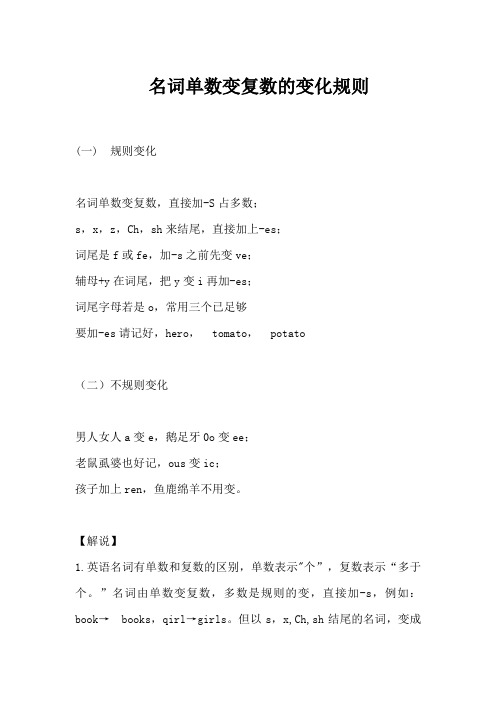
名词单数变复数的变化规则(一)规则变化名词单数变复数,直接加-S占多数;s,x,z,Ch,sh来结尾,直接加上-es;词尾是f或fe,加-s之前先变ve;辅母+y在词尾,把y变i再加-es;词尾字母若是o,常用三个已足够要加-es请记好,hero,tomato,potato(二)不规则变化男人女人a变e,鹅足牙0o变ee;老鼠虱婆也好记,ous变ic;孩子加上ren,鱼鹿绵羊不用变。
【解说】1.英语名词有单数和复数的区别,单数表示"个”,复数表示“多于个。
”名词由单数变复数,多数是规则的变,直接加-s,例如:book→books,qirl→gir ls。
但以s,x,Ch,sh结尾的名词,变成复数时加-es,例如:bus→buses,buzz→buzzes,box→boxes,watch→watches, brush→brushes dress→dresses2.-f(e)结尾的名词单数变复数歌诀:④树叶半数自已黄,妻子拿刀去割粮,架后窜出一只狼,就像强盗逃命忙。
②妻子持刀去宰狼,小愉吓得发了慌,躲在架后保己命,半片树叶遮目光。
例如:leaf-leaves(树叶,叶子),knife-knives 子),wolf--wolves(狼),lifelines,生命),这些名词变成复数时,都要改-f(e)为ve,再加-s3。
-f结尾的名词直接加-s变复数歌诀:海湾边、屋顶上,首领奴仆两相望;谁说他们无信仰,证据写在手帕上。
例如:gulf,roof,chief,serf,belief,proof,h andkerchief,这些名词变复数直接加-s注:scar(围巾;披冈)可以先改f为ve再加-S,也可直接加4.辅音字母+y结尾的名词,把y变i再加-es。
例如:baby→babies,country→countries,family→families;而y前是元音时,y不变,直接加=5。
例如:day→days boy→boys5.以-o结尾的名词变复数时,多数直接加-S。
英语名词单数变复数主要有以下规则
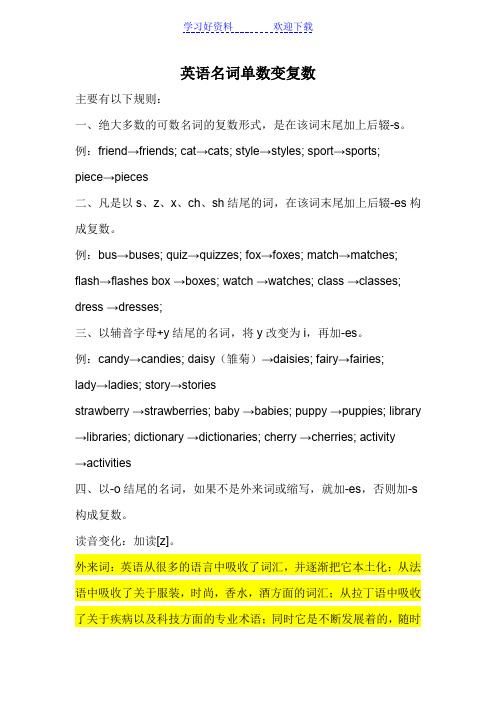
英语名词单数变复数主要有以下规则:一、绝大多数的可数名词的复数形式,是在该词末尾加上后辍-s。
例:friend→friends; cat→cats; style→styles; sport→sports;piece→pieces二、凡是以s、z、x、ch、sh结尾的词,在该词末尾加上后辍-es构成复数。
例:bus→buses; quiz→quizzes; fox→foxes; match→matches; flash→flashes box →boxes; watch →watches;class →classes; dress →dresses;三、以辅音字母+y结尾的名词,将y改变为i,再加-es。
例:candy→candies; daisy(雏菊)→daisies; fairy→fairies;lady→ladies; story→storiesstrawberry →strawberries; baby →babies; puppy →puppies; library →libraries; dictionary →dictionaries; cherry →cher ries; activity→activities四、以-o结尾的名词,如果不是外来词或缩写,就加-es,否则加-s 构成复数。
读音变化:加读[z]。
外来词:英语从很多的语言中吸收了词汇,并逐渐把它本土化:从法语中吸收了关于服装,时尚,香水,酒方面的词汇;从拉丁语中吸收了关于疾病以及科技方面的专业术语;同时它是不断发展着的,随时都有新词在产生着例:tomato→tomatoes; potato→potatoes; torpedo(鱼雷)→torpedoes; bingo(彩票式游戏)→bingo es反例:silo(青贮塔)→silos; piano→pianos(外来词); photo→photos; macro(宏指令,计机算语言)→macros(缩写词)五、以-f或-fe结尾的名词,多为将-f或-fe改变为-ves,但有例外。
英语名词单数变复数规则

英语名词单数变复数的规则一、绝大多数的可数名词的复数形式,是在该词末尾加上后辍-s。
读音变化:结尾是清辅音读[s],结尾是浊辅音或元音读[z].例:friend→friends; cat→cats;style→styles;sport→sports; piece→pieces二、凡是以s、z、x、ch、sh结尾的词,在该词末尾加上后辍—es构成复数.读音变化:统一加读[iz]。
例:bus→buses; quiz→quizzes; fox→foxes; match→matches;flash→flashes三、以辅音字母+y结尾的名词,将y改变为i,再加-es。
读音变化:加读[z]。
例:candy→candies;daisy→daisies; fairy→fairies; lady→ladies; story→stories四、以-o结尾的名词,如果不是外来词或缩写,就加-es,否则加-s构成复数。
读音变化:加读[z]。
例:tomato→tomatoes; potato→potatoes;torpedo→torpedoes;bingo→bingoes反例:silo→silos;piano→pianos(外来词); photo→photos; macro→macros(缩写词)五、以—f或—fe结尾的名词,多为将-f或-fe改变为-ves,但有例外。
读音变化:尾音[f]改读[vz]。
例:knife→knives;life→lives; leaf→leaves;staff→staves; scarf→scarves反例:roof→roofs六、以-us结尾的名词(多为外来词),通常将—us改变为—i构成复数。
读音变化:尾音[Es]改读[ai],其中[kEs]要改读为[sai],[gEs]要改读为[dVai]。
例:fungus→fungi;abacus→abaci; focus→foci; cactus→cacti; cestus→cesti七、以-is结尾的名词,通常将-is改变为-es。
单数名词变复数的规则

单数名词变复数的规则一、直接加s1. 大部分单数名词直接在词尾加s即可变成复数形式。
例如:book -> books,child -> children。
2. 以s结尾的单数名词,直接在词尾加s变成复数形式。
例如:mouse -> mice。
二、词尾加s1. 以x结尾的单数名词,在词尾加s变成复数形式。
例如:cake -> cakes。
2. 以y结尾的单数名词,如果y前面是元音字母,则直接在词尾加s变成复数形式;如果y前面是辅音字母,则变y为i,再加es 变成复数形式。
例如:self -> selves,hour -> hours。
三、词尾变化1. 以le结尾的单数名词,变le为s变成复数形式。
例如:leg -> legs。
2. 以th结尾的单数名词,变th为eth变成复数形式。
例如:truth -> truths。
四、不规则变化1. ox -> oxen,woman -> women,man -> men。
2. 有些单数名词变复数时,需要特殊的变化规则。
例如:child -> children,foot -> feet,tooth -> teeth等。
这些不规则变化的单词需要单独记忆。
总结:单数名词变复数时,需要根据词尾的变化规则进行相应的变化。
有些单数名词变复数时可以直接加s,有些需要在词尾加s或改变词尾的字母。
对于不规则变化的单词,需要单独记忆。
通过掌握这些规则,可以正确地使用单数和复数形式的名词。
名词的单数与复数形式变化规则

名词的单数与复数形式变化规则名词是语言中重要的词类之一,它用来指称人、事物或概念等。
在英语中,名词的单数与复数形式有一定的规则,本文将详细介绍这些规则。
一、一般规则大多数名词的单数形式是通过在词尾加“s”来构成复数形式,例如:1. car – cars (汽车)2. book – books (书籍)3. cat – cats (猫)二、以“s”、“x”、“ch”、“sh” 结尾的名词当名词的单数形式已经以“s”、“x”、“ch”([tʃ])或“sh”([ʃ])结尾时,在词尾加“es”来构成复数形式,例如:1. glass – glasses (玻璃杯)2. box – boxes (盒子)3. church – churches (教堂)4. brush – brushes (刷子)三、以辅音字母+y结尾的名词当名词的单数形式以辅音字母+y结尾时,将“y”改为“i”,再加“es”构成复数形式,例如:1. city – cities (城市)2. baby – babies (婴儿)四、以“f”或“fe”结尾的名词当名词的单数形式以“f”或“fe”结尾时,通常将“f”或“fe”改为“ves”构成复数形式,例如:1. leaf – leaves (树叶)2. knife – knives (刀子)需要注意的是,也有少数名词的复数形式并不遵循上述规则,而是通过不规则变化来构成。
五、不规则复数形式有一些名词的复数形式没有明确的规律,需要记住它们的具体形式。
以下是一些常见的不规则复数形式的例子:1. man – men (男人)2. woman – women (女人)3. child – children (孩子)4. tooth – teeth (牙齿)5. foot – feet (脚)6. mouse – mice (老鼠)7. goose – geese (鹅)8. ox – oxen (牛)六、复数形式作为‘单位’或‘整体’使用当复数形式的名词作为整体或表示单位时,谓语动词通常使用单数形式。
英语名词单数变复数的规则

英语名词单数变复数的规则规则变化一、绝大多数的可数名词的复数形式,是在该词末尾加上后辍-s。
(读音变化:结尾是清辅音读[s],结尾是浊辅音或元音读[z]。
) 例:friend→friends; cat→cats; style→styles; sport→sports; desk→desks二、凡是以s、x、ch、sh结尾的词,在该词末尾加上后辍-es构成复数。
读音变化:统一加读[iz]。
例:bus→buses; fox→foxes; match→matches; dish→dishes ;box→boxes三、以辅音字母+y结尾的名词,将y改变为i,再加-es。
读音变化:加读[z]。
例:candy→candies; baby→babies; family→families; lady →ladies; story→stories但是以元音字母+y 结尾的词,在词尾加s 例:boy→ boys;day→days;key→keys;toy→toys四、以-o结尾的名词,如果不是外来词或缩写,就加-es,否则加-s 构成复数。
读音变化:加读[z]。
例:tomato→tomatoes; potato →potatoes;hero→heroes;但是有少数几个直接s :photo→photos; piano→pianos五、以-f或-fe结尾的名词,多为将-f或-fe改变为-ves。
读音变化:尾音[f]改读[vz]。
例:knife→knives; life→lives; leaf→leaves; staff→staves; scarf→scarves但有例外:roof→roofs不规则变化①含man的名词,一般变man为men。
如woman→women, policeman →policemen, Englishman→Englishmen。
但German→Germans。
②将oo改为ee的有foot→feet, tooth→teeth, goose→geese 等。
英语名词单数变复数规则

英语名词单数变复数的规则一、绝大多数的可数名词的复数形式,是在该词末尾加上后辍-s。
读音变化:结尾是清辅音读[s],结尾是浊辅音或元音读[z]。
例:friend→friends; cat→cats; style→styles; sport→sports; piece→pieces二、凡是以s、z、x、ch、sh结尾的词,在该词末尾加上后辍-es构成复数。
读音变化:统一加读[iz]。
例:bus→buses; quiz→quizzes; fox→foxes; match→matches; flash→flashes三、以辅音字母+y结尾的名词,将y改变为i,再加-es。
读音变化:加读[z]。
例:candy→candies; daisy→daisies; fairy→fairies; lady→ladies; story→stories四、以-o结尾的名词,如果不是外来词或缩写,就加-es,否则加-s构成复数。
读音变化:加读[z]。
例:tomato→tomatoes; potato→potatoes; torpedo→torpedoes; bingo→bingoes反例:silo→silos; piano→pianos(外来词); photo→photos; macro→macros(缩写词)五、以-f或-fe结尾的名词,多为将-f或-fe改变为-ves,但有例外。
读音变化:尾音[f]改读[vz]。
例:knife→knives; life→lives; leaf→leaves; staff→staves; scarf→scarves反例:roof→roofs六、以-us结尾的名词(多为外来词),通常将-us改变为-i构成复数。
读音变化:尾音[Es]改读[ai],其中[kEs]要改读为[sai],[gEs]要改读为[dVai]。
例:fungus→fungi; abacus→abaci; focus→foci; cactus→cacti; cestus→cesti七、以-is结尾的名词,通常将-is改变为-es。
名词单数变复数规则口诀

名词单数变复数规则口诀(一)规则变化名词单数变复数,直接加-s占多数;s,x,z,ch,sh来结尾,直接加上-es;词尾是f或fe,加-s之前先变ve;辅母+y在词尾,把y变i再加-es;词尾字母若是o,常用三个已足够,要加-es请记好,hero,tomato,potato。
(二)不规则变化男人女人a变e,鹅足牙oo变ee;老鼠虱婆也好记,ous变ic;孩子加上ren,鱼鹿绵羊不用变。
解释1.英语名词有单数和复数的区别,单数表示“一”,复数表示“多于一。
”名词由单数变复数,多数是规则的变,直接加-s,例如:book→books,girl→girls。
但以-s,-z,-x,-ch,-sh结尾的名词,变成复数时加-es,例如:bus→buses,buzz→buzzes,box→boxes,watch→watches,brush→brushes2.-f(e)结尾的名词单数变复数歌诀:①树叶半数自已黄,妻子拿刀去割粮,架后窜出一只狼,就像强盗逃命忙。
②妻子持刀去宰狼,小偷吓得发了慌,躲在架后保己命,半片树叶遮目光。
例如:leaf(树叶,叶子),half(一半),self(自已),wife(妻子),knife(刀子),shelf(架子),wolf(狼),thief(窃贼,强盗)和life(生命),这些名词变成复数时,都要改-f(e)为v,再加-es。
3.-f结尾的名词直接加-s变复数歌诀:海湾边、屋顶上,首领奴仆两相望;谁说他们无信仰,证据写在手帕上。
例如:gulf,roof,chief,serf,belief,proof,handkerchief,这些名词变复数直接加-s。
注:scarf(围巾;披风)可以先改f为ve再加-s,也可直接加-s。
4.辅音字母+y结尾的名词,把y变i加-es。
例如:baby→babies,country→countries,family→families;而-y前是元音时,-y不变,直接加-s。
英语名词单数变复数主要有以下规则
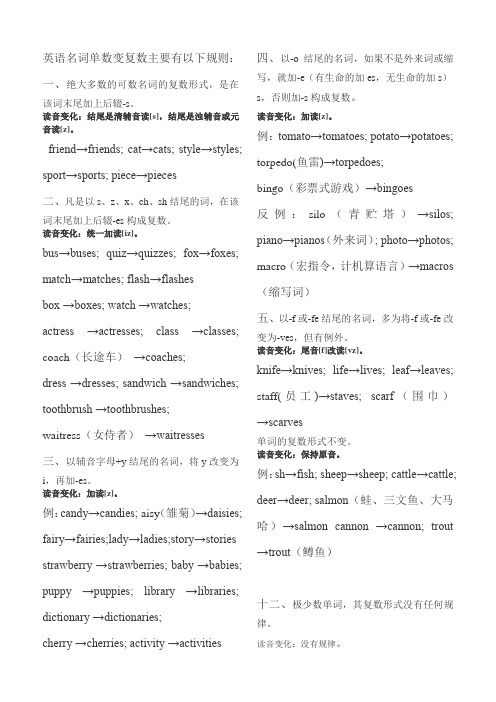
英语名词单数变复数主要有以下规则:一、绝大多数的可数名词的复数形式,是在该词末尾加上后辍-s。
读音变化:结尾是清辅音读[s],结尾是浊辅音或元音读[z]。
friend→friends; cat→cats; style→styles; sport→sports; piece→pieces二、凡是以s、z、x、ch、sh结尾的词,在该词末尾加上后辍-es构成复数。
读音变化:统一加读[iz]。
bus→buses; quiz→quizzes; fox→foxes; match→matches; flash→flashesbox →boxes; watch →watches;actress →actresses; class →classes; coach(长途车)→coaches;dress →dresses; sandwich →sandwiches; toothbrush →toothbrushes;waitress(女侍者)→waitresses三、以辅音字母+y结尾的名词,将y改变为i,再加-es。
读音变化:加读[z]。
例:candy→candies; aisy(雏菊)→daisies; fairy→fairies;lady→ladies;story→stories strawberry →strawberries; baby →babies; puppy →puppies; library →libraries; dictionary →dictionaries;cherry →cherries; activity →activities 四、以-o结尾的名词,如果不是外来词或缩写,就加-e(有生命的加es,无生命的加s)s,否则加-s构成复数。
读音变化:加读[z]。
例:tomato→tomatoes; potato→potatoes; torpedo(鱼雷)→torpedoes;bingo(彩票式游戏)→bingoes反例:silo(青贮塔)→silos; piano→pianos(外来词); photo→photos; macro(宏指令,计机算语言)→macros (缩写词)五、以-f或-fe结尾的名词,多为将-f或-fe改变为-ves,但有例外。
英语名词单数变复数的规则
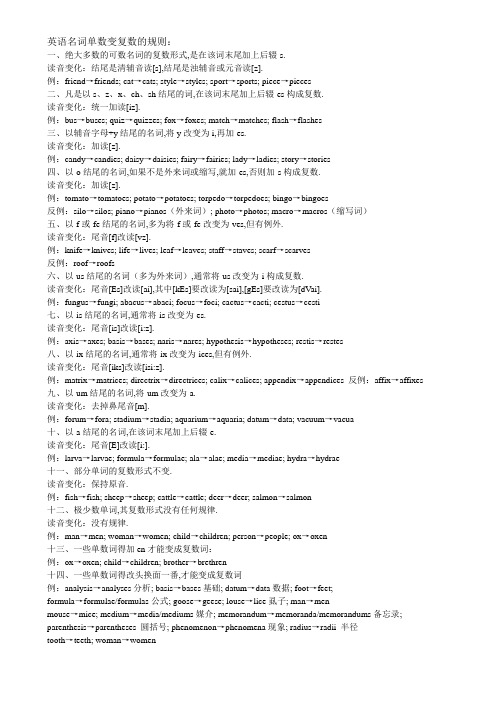
英语名词单数变复数的规则:一、绝大多数的可数名词的复数形式,是在该词末尾加上后辍-s.读音变化:结尾是清辅音读[s],结尾是浊辅音或元音读[z].例:friend→friends; cat→cats; style→styles; sport→sports; piece→pieces二、凡是以s、z、x、ch、sh结尾的词,在该词末尾加上后辍-es构成复数.读音变化:统一加读[iz].例:bus→buses; quiz→quizzes; fox→foxes; match→matches; flash→flashes三、以辅音字母+y结尾的名词,将y改变为i,再加-es.读音变化:加读[z].例:candy→candies; daisy→daisies; fairy→fairies; lady→ladies; story→stories四、以-o结尾的名词,如果不是外来词或缩写,就加-es,否则加-s构成复数.读音变化:加读[z].例:tomato→tomatoes; potato→potatoes; torpedo→torpedoes; bingo→bingoes反例:silo→silos; piano→pianos(外来词); photo→photos; macro→macros(缩写词)五、以-f或-fe结尾的名词,多为将-f或-fe改变为-ves,但有例外.读音变化:尾音[f]改读[vz].例:knife→knives; life→lives; leaf→leaves; staff→staves; scarf→scarves反例:roof→roofs六、以-us结尾的名词(多为外来词),通常将-us改变为-i构成复数.读音变化:尾音[Es]改读[ai],其中[kEs]要改读为[sai],[gEs]要改读为[dVai].例:fungus→fungi; abacus→abaci; focus→foci; cactus→cacti; cestus→cesti七、以-is结尾的名词,通常将-is改变为-es.读音变化:尾音[is]改读[i:z].例:axis→axes; basis→bases; naris→nares; hypothesis→hypotheses; restis→restes八、以-ix结尾的名词,通常将-ix改变为-ices,但有例外.读音变化:尾音[iks]改读[isi:z].例:matrix→matrices; directrix→directrices; calix→calices; appendix→appendices 反例:affix→affixes 九、以-um结尾的名词,将-um改变为-a.读音变化:去掉鼻尾音[m].例:forum→fora; stadium→stadia; aquarium→aquaria; datum→data; vacuum→vacua十、以-a结尾的名词,在该词末尾加上后辍-e.读音变化:尾音[E]改读[i:].例:larva→larvae; formula→formulae; ala→alae; media→mediae; hydra→hydrae十一、部分单词的复数形式不变.读音变化:保持原音.例:fish→fish; sheep→sheep; cattle→cattle; deer→deer; salmon→salmon十二、极少数单词,其复数形式没有任何规律.读音变化:没有规律.例:man→men; woman→women; child→children; person→people; ox→oxen十三、一些单数词得加en才能变成复数词:例:ox→oxen; child→children; brother→brethren十四、一些单数词得改头换面一番,才能变成复数词例:analysis→analyses分析; basis→bases基础; datum→data数据; foot→feet;formula→formulae/formulas公式; goose→geese; louse→lice虱子; man→menmouse→mice; medium→media/mediums媒介; memorandum→memoranda/memorandums备忘录; parenthesis→parentheses 圆括号; phenomenon→phenomena现象; radius→radii 半径tooth→teeth; woman→women十五、有些名词是单数、复数不分的例:deer; fish; cannon; sheep; salmon 鲑鱼; trout 鳟鱼十六、一些名词虽分单数、复数,但出现次数多的总是单数词例:abscence; clothing; film; help; furniture家具; machinery机械; news; scenery风景; sugar; traffic交通十七、另一些名词则以复数词出现的机会较多例:bellows风箱; clothes; police; shorts短裤; scissors剪刀; spectacles眼镜; shears大剪刀trousers长裤; wages工资十八、compound nouns,这类复数词是以主要的名词来表示例:daughter-in-law→daughters-in-law 媳妇; father-in-law→fathers-in-law岳父man-of-war→men-of-war兵舰; maid-servant→maid-servantsstep-son→step-sons晚子; son-in-law→sons-in-law十九、若表达具体数目,要借助数量词例:pair(对,双); suit(套); a pair of glasses; two pairs of trousers二十、另外还有一些名词,其复数形式有时可表示特别意思,例:goods货物,waters水域,fishes(各种)鱼二十一、除人民币元、角、分外,美元、英镑、法郎等都有复数形式.。
英语名词单数变复数的规则
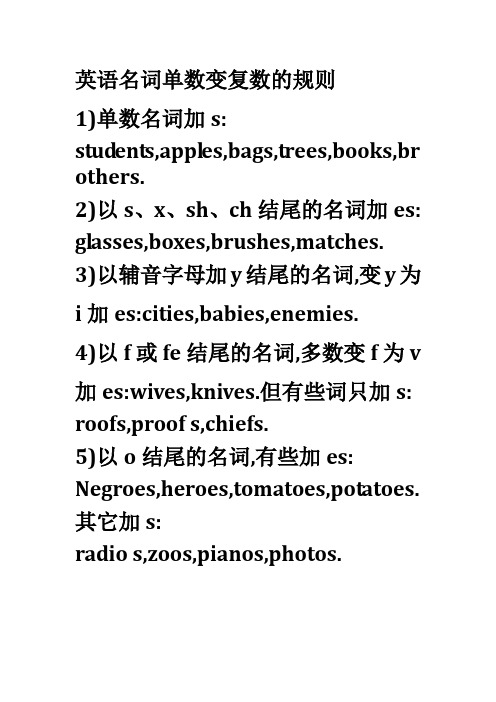
英语名词单数变复数的规则1)单数名词加s:students,apples,bags,trees,books,br2)以s、x、sh、ch结尾的名词加es:3)以辅音字母加y结尾的名词,变y为i加4)以f或fe结尾的名词,多数变f为v 加es:wives,knives.但有些词只加s:5)以o结尾的名词,有些加es: Negroes,heroes,tomatoes,potatoes.其它加s:6)不规则名词:foot→feet,goose→geese,tooth→teet h,child→children,man→men,woman→women,sheep→sheep,de er→deer,mouse→mice.7)某些外来词变复数:datum→data,medium→media,bacte rium→bacteria,curriculum→curric ula,criterion→criteria,phenomeno n→→lysis→analyses,basis→bases,crisis→crises,diagnosis→→e8)复合名词变复数:以不可数名词结尾的复合名词无复数形式,如:以man或woman为前缀的复合名词变复数,前后两个名词都变复数,如:manservant→menservants,womanstudent women stud其它复合名词变复数:→→→9)复合形容词做定语时,其中的名词保持单数:名词复数:英语中名词可分为可数名词和不可数名词.可数名词在应用时有单数和复数形式.表示一个用单数,表示两个或两个以上用复数.复数名词的构成分为规则变化和不规则变化.1.规则变化:1) 一般在名词词尾加s,① map—maps地图,bird—birds鸟, orange—oranges 桔子, bike—bikes自行车;2) 以s,x,ch,sh结尾的名词加es,① box—boxes盒子,class—classes班级,watch—watches手表,dish-dishes盘,碟子,餐具;3) 以O结尾的名词后面加s或es①photo—photos相片radio—radios收音机zoo—zoos动物园tomato—tomatoes西红柿potato—potatoes土豆4) 以辅音字母加y结尾的名词,变y 为i+es①baby—babies婴儿family—families家庭;以元音字母加y结尾的名词直接加s① boy—boys男孩toy—toys 玩具;5) 以fe或f结尾的名词,把fe或f变为ves① knife—knives小刀wife—wives妻子leaf—leaves树叶.二:名词复数的不规则变化1)child---children foot---feet tooth---teethmouse---mice man---men woman---women注意:与man 和woman构成的合成词,其复数形式也是-men 和-women.如:an Englishman,two Englishmen.但German不是合成词,故复数形式为Germans;Bowman是姓,其复数是the Bowmans.2)单复同形如:deer,sheep,fish,Chinese,Japanese li,jin,yuan,two li,three mu,four jin 但除人民币元、角、分外,美元、英镑、法郎等都有复数形式.如:a dollar,two dollars; a meter,two meters3)集体名词,以单数形式出现,但实为复数.如:people police cattle 等本身就是复数,不能说 a people,a police,acattle,但可以说a person,a policeman,a head of cattle,the English,the British,the French,the Chinese,the Japanese,the Swiss 等名词,表示国民总称时,作复数用.如:The Chinese are industries and brave.中国人民是勤劳勇敢的.4)以s结尾,仍为单数的名词,如:a.maths,politics,physics等学科名词,为不可数名词,是单数.b.news 是不可数名词.c.the United States,the United Nations 应视为单数.The United Nations was organized in 1945.联合国是1945年组建起来的.d.以复数形式出现的书名,剧名,报纸,杂志名,也可视为单数."The Arabian Nights" is a very interesting story-book.是一本非常有趣的故事书.5) 表示由两部分构成的东西,如:glasses (眼镜) trousers,clothes若表达具体数目,要借助数量词pair(对,双); suit(套); a pair of glasses; two pairs of trousers6)另外还有一些名词,其复数形式有时可表示特别意思,如:goods货物,waters水域,fishes(各种)鱼。
英语名词单数变复数规则
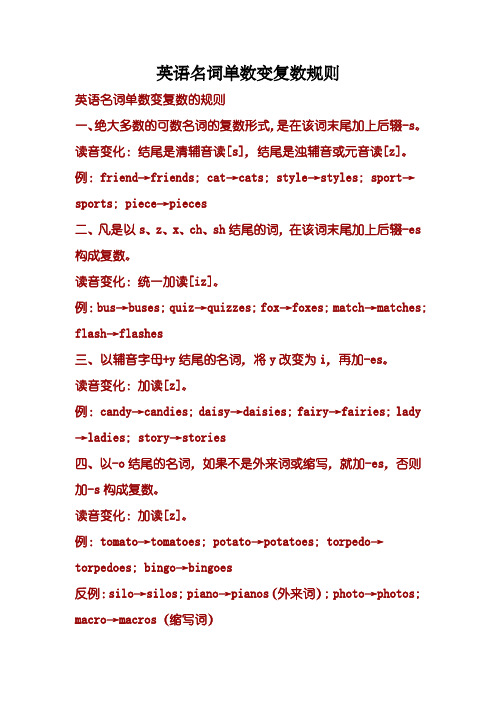
英语名词单数变复数规则英语名词单数变复数的规则一、绝大多数的可数名词的复数形式,是在该词末尾加上后辍-s。
读音变化:结尾是清辅音读[s],结尾是浊辅音或元音读[z]。
例:friend→friends; cat→cats; style→styles; sport→sports; piece→pieces二、凡是以s、z、x、ch、sh结尾的词,在该词末尾加上后辍-es 构成复数。
读音变化:统一加读[iz]。
例:bus→buses; quiz→quizzes; fox→foxes; match→matches; flash→flashes三、以辅音字母+y结尾的名词,将y改变为i,再加-es。
读音变化:加读[z]。
例:candy→candies; daisy→daisies; fairy→fairies; lady →ladies; story→stories四、以-o结尾的名词,如果不是外来词或缩写,就加-es,否则加-s构成复数。
读音变化:加读[z]。
例:tomato→tomatoes; potato→potatoes; torpedo→torpedoes; bingo→bingoes反例:silo→silos; piano→pianos(外来词); photo→photos; macro→macros(缩写词)五、以-f或-fe结尾的名词,多为将-f或-fe改变为-ves,但有例外。
读音变化:尾音[f]改读[vz]。
例:knife→knives; life→lives; leaf→leaves; staff→staves; scarf→scarves反例:roof→roofs六、以-us结尾的名词(多为外来词),通常将-us改变为-i构成复数。
读音变化:尾音[Es]改读[ai],其中[kEs]要改读为[sai],[gEs]要改读为[dVai]。
例:fungus→fungi; abacus→abaci; focus→foci; cactus→cacti; cestus→cesti七、以-is结尾的名词,通常将-is改变为-es。
单数变复数的规则
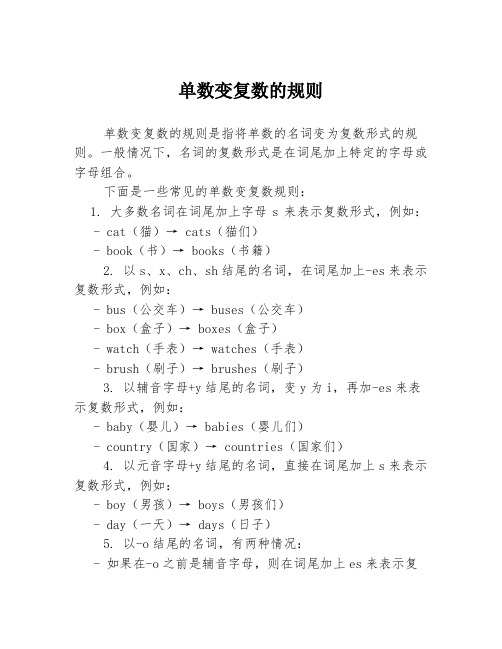
单数变复数的规则单数变复数的规则是指将单数的名词变为复数形式的规则。
一般情况下,名词的复数形式是在词尾加上特定的字母或字母组合。
下面是一些常见的单数变复数规则:1. 大多数名词在词尾加上字母s来表示复数形式,例如: - cat(猫)→ cats(猫们)- book(书)→ books(书籍)2. 以s、x、ch、sh结尾的名词,在词尾加上-es来表示复数形式,例如:- bus(公交车)→ buses(公交车)- box(盒子)→ boxes(盒子)- watch(手表)→ watches(手表)- brush(刷子)→ brushes(刷子)3. 以辅音字母+y结尾的名词,变y为i,再加-es来表示复数形式,例如:- baby(婴儿)→ babies(婴儿们)- country(国家)→ countries(国家们)4. 以元音字母+y结尾的名词,直接在词尾加上s来表示复数形式,例如:- boy(男孩)→ boys(男孩们)- day(一天)→ days(日子)5. 以-o结尾的名词,有两种情况:- 如果在-o之前是辅音字母,则在词尾加上es来表示复数形式,例如:- potato(土豆)→ potatoes(土豆)- 如果在-o之前是元音字母,则直接在词尾加上s来表示复数形式,例如:- zoo(动物园)→ zoos(动物园)6. 以-f或-fe结尾的名词,变f或fe为v,再加-es来表示复数形式,例如:- leaf(叶子)→ leaves(叶子)- wolf(狼)→ wolves(狼)7. 一些名词的复数形式不遵循上述规则,需要进行不规则变化,例如:- man(男人)→ men(男人)- woman(女人)→ women(女人)- child(孩子)→ children(孩子们)- foot(脚)→ feet(脚)需要注意的是,还有一些特殊情况需要记住,如:- 有些名词的单数和复数形式相同,例如:- deer(鹿)→ deer(鹿)- sheep(羊)→ sheep(羊)以上就是单数变复数的常见规则。
- 1、下载文档前请自行甄别文档内容的完整性,平台不提供额外的编辑、内容补充、找答案等附加服务。
- 2、"仅部分预览"的文档,不可在线预览部分如存在完整性等问题,可反馈申请退款(可完整预览的文档不适用该条件!)。
- 3、如文档侵犯您的权益,请联系客服反馈,我们会尽快为您处理(人工客服工作时间:9:00-18:30)。
英语名词单数变复数规则★清华大学★英语系测试:为中小学生英语量身定做.官方网站:/清华大学英语教授研究组提供英语名词单数变复数的规则一、绝大多数的可数名词的复数形式,是在该词末尾加上后辍-s。
读音变化:结尾是清辅音读[s],结尾是浊辅音或元音读[z]。
例:friend→friends; cat→cats; style→styles; sport→sports; piece→pieces二、凡是以s、z、x、ch、sh结尾的词,在该词末尾加上后辍-es 构成复数。
读音变化:统一加读[iz]。
例:bus→buses; quiz→quizzes; fox→foxes; match→matches; flash→flashes三、以辅音字母+y结尾的名词,将y改变为i,再加-es。
读音变化:加读[z]。
例:candy→candies; daisy→daisies; fairy→fairies; lady →ladies; story→stories四、以-o结尾的名词,如果不是外来词或缩写,就加-es,否则加-s构成复数。
读音变化:加读[z]。
例:tomato→tomatoes; potato→potatoes; torpedo→torpedoes; bingo→bingoes反例:silo→silos; piano→pianos(外来词); photo→photos; macro→macros(缩写词)五、以-f或-fe结尾的名词,多为将-f或-fe改变为-ves,但有例外。
读音变化:尾音[f]改读[vz]。
例:knife→knives; life→lives; leaf→leaves; staff→staves; scarf→scarves反例:roof→roofs六、以-us结尾的名词(多为外来词),通常将-us改变为-i构成复数。
读音变化:尾音[Es]改读[ai],其中[kEs]要改读为[sai],[gEs]要改读为[dVai]。
例:fungus→fungi; abacus→abaci; focus→foci; cactus→cacti; cestus→cesti七、以-is结尾的名词,通常将-is改变为-es。
读音变化:尾音[is]改读[i:z]。
例:axis→axes; basis→bases; naris→nares; hypothesis →hypotheses; restis→restes八、以-ix结尾的名词,通常将-ix改变为-ices,但有例外。
读音变化:尾音[iks]改读[isi:z]。
例:matrix→matrices; directrix→directrices; calix→calices; appendix→appendices 反例:affix→affixes九、以-um结尾的名词,将-um改变为-a。
读音变化:去掉鼻尾音。
例:forum→fora; stadium→stadia; aquarium→aquaria; datum→data; vacuum→vacua十、以-a结尾的名词,在该词末尾加上后辍-e。
读音变化:尾音[E]改读[i:]。
例:larva→larvae; formula→formulae; ala→alae; media →mediae; hydra→hydrae十一、部分单词的复数形式不变。
读音变化:保持原音。
例:fish→fish; sheep→sheep; cattle→cattle; deer→deer; salmon→salmon十二、极少数单词,其复数形式没有任何规律。
读音变化:没有规律。
例:man→men; woman→women; child→children; person→people; ox→oxen十三、一些单数词得加en才能变成复数词:例:ox→oxen; child→children; brother→brethren十四、一些单数词得改头换面一番,才能变成复数词例:analysis→analyses分析; basis→bases基础; datum→data数据; foot→feet;formula→formulae/formulas公式; goose→geese; louse→lice虱子; man→menmouse→mice; medium→media/mediums媒介; memorandum→memoranda/memorandums备忘录;parenthesis→parentheses 圆括号; phenomenon→phenomena 现象; radius→radii 半径tooth→teeth; woman→women十五、有些名词是单数、复数不分的例:deer; fish; cannon; sheep; salmon 鲑鱼; trout 鳟鱼十六、一些名词虽分单数、复数,但出现次数多的总是单数词例:abscence; clothing; film; help; furniture家具; machinery机械; news; scenery风景; sugar;traffic交通十七、另一些名词则以复数词出现的机会较多例:bellows风箱; clothes; police; shorts短裤; scissors 剪刀; spectacles眼镜; shears大剪刀trousers长裤; wages工资十八、compound nouns,这类复数词是以主要的名词来表示例:daughter-in-law→daughters-in-law 媳妇;father-in-law→fathers-in-law岳父man-of-war→men-of-war兵舰; maid-servant→maid-servants step-son→step-sons晚子; son-in-law→sons-in-law十九、若表达具体数目,要借助数量词例:pair(对,双); suit(套); a pair of glasses; two pairs of trousers二十、另外还有一些名词,其复数形式有时可表示特别意思,例:goods货物,waters水域,fishes(各种)鱼二十一、除人民币元、角、分外,美元、英镑、法郎等都有复数形式。
例:a dollar, two dollars; a meter, two meters以O结尾的词,许多加es构成复数,特别是一些常用词如:heroes,potatoes,tomatoes,echoes,tornadoes,torpedoes,do minoes,vetoes,mosquitoes,Negroes,mangoes,buffaloes,vol canoes但下面几类词只加s:1.以“元音+o”或“oo”结尾的词如:videos,radios,studios,folios,oratorios,embryos,zoos ,bamboos,kangaroos,taboos2.一些外来词,特别是音乐方面的词,如:pianos,solos,concertos,tobaccos,mottos,cellos3.一些缩写词和专有名词,如:kilos,photos,memos,micros,Eskimos,Filipnos有个别词加两种词尾都可新目标英语八年级(上)期末试题(二)I.释义从下列选项中,选出一个与句子画线部分意思相同或相近的答案。
(5分)()1. We got over 1000 letters , faxes and e-mails from our readers.A. someB. moreC. more thanD. many()2. I have to go to a meeting.A. mustB. has toC. needD. had to()3. Please take care of yourself.A. look forB. look atC. look afterD. look over()4. How about going fishing ?A. What aboutB. Why notC. Why don’tD. Shall we ()5. Finally he got a very good job.A. At lastB. At the endC. At the end ofD. At firstII.选择填空 (20分)()6. ---_________ do you exercise ? ----- Every day.A. WhenB. WhatC. How longD. How often ()7.She ______ TV every day .A. seesB. looks atC. watchesD.looks ()8.There is ______ elephant over there.A. aB. anC. theD. /()9. ---What’s the matter ______ you ? ---- I havea bad cold.A. forB. withC. toD. on()10. --- What are you doing for vacation . ---- I ____ my sister.A. babysittingB. are babysittingC. is babysittingD. am babysitting()11.______ are they going ? They are going on Monday.A. WhatB. WhenC. What timeD. How()12.It _____ me about 10 minutes to walk there.A. takeB. takesC. spendD. spends()13. In America, most students go to school _____ the school bus.A. inB. onC. byD. at()14. Can you come to my party , Ted ? _____________ .A. Sorry, I ‘d likeB. Sure, I’d love toC. Sure, I can’tD. Yes , I’d like.()15. Can you come to my party ______ Saturday afternoon ?A. onB. inC. atD. about()16.He ______ short hair. He ____ calm.A. is/ isB. has/hasC. is/hasD. has/is ()17. This story is _______ than that one.A. funB. funnyC. funnerD. funnier()18. She often makes me ______ . 16-20DDABCA. laughB. to laughC. laughingD. laughs ()19. We both enjoy ______ to parties.A. goB. goingC. goesD. went()20.Do you like tomatoes ? --_________.A. Yes, you doB. No, you don’tC. Yes , I doD. No, I do()21. Frank ________ a toy horse yesterday.A. don’t buyB. buysC. boughtD. buy()22. On my next day _____ , I don’t want to go _____ a drive.A. in ,onB. off, forC. of , forD. off, of ()23 He _______ in 1998.A. is bornB. was bornC. is birthD. was birth ()24. Could I please use your ruler ? __________.A. Sorry, you can’t.B. Not at allC. That’s rightD. Yes, you can’t()25. Who writes _______ , Jim , Kate or John ?A. the most carefullyB. more carefullyC. the most carefulD. more carefulIII.按顺序排列对话,将正确的序号写在横线上(5分)a.About two days ago.b.What’s the matter ?c.I’m not feeling well. I have a cold.d.When did it starte.Oh, that’s too bad. You should get some rest.26—30 ______ ______ ______ ______ _______IV.将恰当的答语的序号填入相应的问句的括号里.(5分)()31.What are you going to be when you grow up ? a. Yes, a little()32.Could you clean your room ? b. I’m going to be an engineer.()33.How often do you eat fast food ? c. It was exciting.()34.Are you feeling hungry ? d. Sorry, I can’t. I have to do my homework.()35.How was your school trip ? e. Sometimes.V. 完形填空. (5分)Nancy,Thanks for36______ my dog. Could youplease37_______ these things every day ?Take him for a walk . Give38________water and feedhim. Then wash his bowl.Play39______him.40_______to clean his bed. Have fun ! See you next week.Thanks,Thomas()36. A. taking care of B. take care of C. take care D. taking of()37. A. do B. does C. doing D. to do ()38. A. his B. her C. him D. me ()39. A. for B.at C. with D. to()40. A. Don’t forget B.Don’t remember C. Not forgetting D. ForgetVI. 阅读理解( 30 分)AJim was bornin a small village. his father,Mr.Brown,has a big farm a ndworks hard on it .He often gets good harvests.Now Jim is six years old ,butthere'sno school near the village. He is very worried."My sister works in London."says Mrs,Brown. "We can take Jim to school there. what doyou think of it ?""It's a good idea!"Mr Brown said happily.The next day they all went to London by train. Jim's auntwas glad to see them.A week later, Jim came to school."What's your name,little boy?" asked a teacher. "Jim Brown."answered the boy."You must be polite ," said the teacher,"please say 'sir' when you are speaking to the old.Now answermy question again.What's your name?" "Sir Jim Brown." ()41.The Brown lives in a small village in ____.A.ChinaB.AmericaC.EnglandD.Australia() 42.Mr. Brown is ____.A.a farmerB.a teacherC.a workerD. a college student()43.Mr. and Mrs.Brown took their son to London because_______.A.there're many nice schools in the cityB.they want Jim to play there.C.they have no time to look after Jim.()44.The teacher wanted Jim_____.A.to be polite to the young.B.to know how to say sir.C.to know how to speak English.D.to know how t o speak to the old.()45.The boy called himself "sir JimBrown" because______.A. his name was Jim BrownB. he wasn't polite to the teacherC. he didn't know how to use the word "sir"D. he was born in a small villageBLucy likes English very much. She works hard. She reads English every morning.She likes speaking English. She often listens to the radio. She likes watching TV. But sheonly watches it on Saturday evening. She doesn’t like dancing. But she likes singing.She sings very well . She likes driving a car, too. Her parents like her. And all theteachers like her, too.()46. Does Lucy read English in themorning? ______________.A. Yes, she doesB. Yes, she isC. No, she doesn’tD. No, she isn’t()47. When does she watch TV?A. Every eveningB. On Saturday eveningC. On Sunday()48.She likes singing and ______.A. dancingB. swimmingC. playing gamesD. driving a car()49.Who likes her ? ________________.A. Her parentsB. Her teachersC. Herclassmates D. A and B()50. From the story , we may know Lucy is ______.A. a good teacherB. a good driverC. a good studentD. a good AmericanC根据短文内容判断句子正(T)误(F)Many children love junk food. It’s bad for theirhealth.Their parents don’t want them to eat toomuch junk food. Although they know it’s not good habit,they still eat it.Some of them eat thiskind of food every day.Some only once or twice a week. Paul is kind of unhealthy.He hardly ever exercises.He eats lots of junk food because he lovesit.When he has money,he’ll buy junk food.His parents worry about him.But he says,“MaybeI’m not very healthy,but I enjoy myself.”( )51.Few children love junk food.( )52.Many parents want their children to eat junk food. ( )53.Children know it’s a bad habit to eat junk food. ( )54.Paul is very healthy.( )55.Paul often brrows money to buy junk food.VII. 单词拼写.(5分)66.Then ______ hot water into the blender. (倒-- )67.I like to ______ my bike on the weekend. (骑 )68. I helped Sally _____ a new watch.. (买 )69. She _______ doing the dishes. It’s so boring. (讨厌 )70.He’s ________ for Hong Kong on Tuesday. (动身前往--- )VIII. 句子翻译.(10分)71.先将一个洋葱切碎,然后加些到煎饼上。
